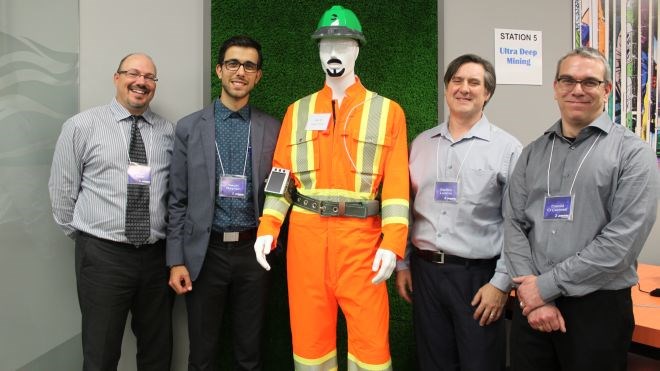As early as next spring, Jannatec Technologies could debut the first components of its wearable technology, which will help cool underground miners, monitor their vital signs and enhance their overall health and safety.
A contributor to the Ultra-Deep Mining Network, the Sudbury-based company has been working for three years on the technology that will allow miners to work in mines that descend to 2.5 kilometres or more.
As mines get deeper, temperatures are hotter, miners are more isolated, and it takes longer to ascend to surface. Companies like Jannatec are developing technology to combat the heat, isolation and other challenges miners may encounter.
“What we’ve done is developed a data hub, which is a wearable computer with the same functionality as a cell phone, without the ability to make calls necessarily, and that works as the backbone of the whole thing,” said Steffon Luoma, Jannatec’s senior research scientist, during a recent open house at the facility.
That data hub “talks” to other modules that all connect to one system designed to serve various functions while underground.
An environmental sensor module measures the temperature and humidity at a miner’s location, so that the miner can determine whether they can safety continue to work. It connects to a vest, worn by the miner under their coveralls, with 12 modules that can actually remove heat from the body.
Everyone responds differently to heat, Luoma said, and a miner’s temperature could be influenced by things like how well they’ve acclimatized, or even what they’ve had to eat.
“You can always check and see what your temperature is and modify your behaviour according to the conditions,” Luoma said. “And it can also send out an alert if it’s too hot to work.”
Sensors in the brim of an integrated helmet can measure the heart rate and skin temperature of the miner, indicating if they are overexerting themselves and need to take a rest. It also comes equipped with LED lights, which emit a bright blue light that’s highly visible underground and changes to a red warning light if a vehicle is in the vicinity.
The helmet’s camera, which switches off when not in use, can record video clips or photos to the data hub. It’s useful if a miner wants to snap a photo of some interesting geology to show a geologist back on surface, or needs a closeup of a piece of underground equipment for the mechanic who will be doing maintenance on the machine. Eventually, the technology could evolve to allow a Skype-like video call, which would allow miners to connect to someone on surface, in real time.
The final component is a newly designed coverall, which has been made with comfort and durability in mind.
“We’ve added features like increased mobility in the arms and upper torso, as well as cooling vents, so that the heat doesn’t get trapped,” Luoma said. “By making it more comfortable, they can wear a proper size as opposed to oversizing it and having it bunch up and collect more heat, so it’s thermally more comfortable.”
Jason Buie, Jannatec’s manager of research and development, said each of the components is designed to work either together as part of a whole system, or separately.
Mines and military organizations have already shown interest in some of the components; in particular, the heating and cooling potential of the thermal system, Buie noted.
The time for commercialization is getting closer, but some components are still being tweaked before they’re released.
The integrated helmet is going through a redesign, and the data hub itself needs to become sleeker, so it looks “more like a product, and not like a project,” Buie added.
“Our main goal is to get things working and get things communicating and talking, and then we’ll worry about making it pretty after that’s all sorted out,” he said.
Still, it’s a huge advancement in technology that once sounded like a futuristic ideal.
Over the last three years, Jannatec president Wayne Ablitt said, the company has invested $4.2 million in research and development, which includes support for its new JETLab.
Launched in 2016, the lab is the new home of Jannatec’s engineering group. The idea was to create an area where engineers and designers could focus on development that could also serve as a recruitment and retention incentive for future workers.
With an open concept, modern décor, and fun add-ons like a pool table, the space resembles the headquarters for multi-million-dollar companies like Facebook or Google. And that’s the point.
“We wanted to change our environment from the old, traditional way we did business,” Ablitt said. “We’re trying to bring back the fun side of the business.”
So far, it seems to be working. Ablitt said his staff have worked hard to get the products to this point, and the investment has been worth it.
“We’re getting close to the marketing side of this product,” he said. “We’ll probably, within the next year, be potentially putting a lot of this equipment underground.”




